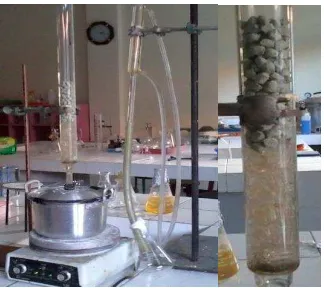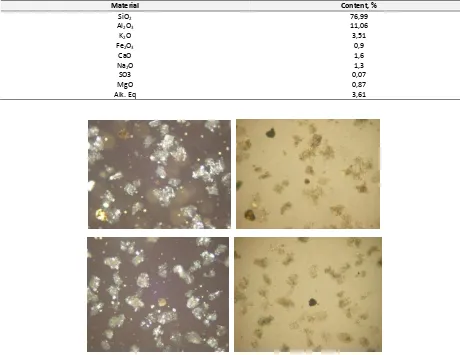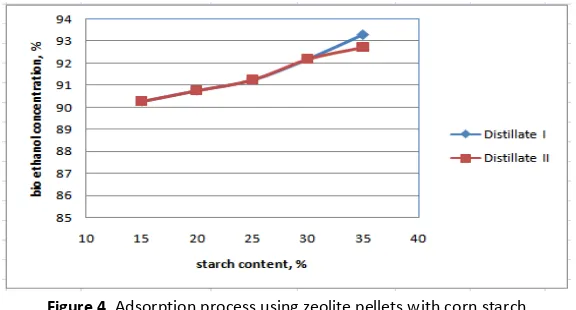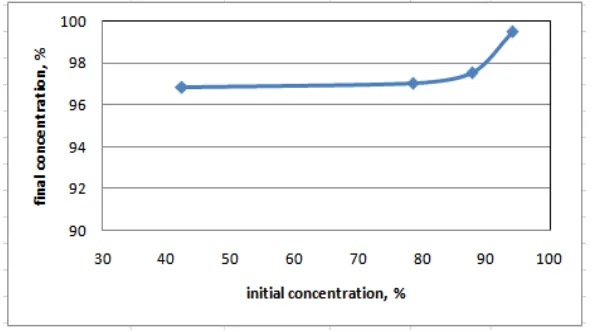Synthesis of Zeolite Pellets From Natural Zeolite and
Starch as Adsorbent For Fuel Grade Bioethanol
Production
A war Ma’ruf, Neni Damajanti
Chemical Engineering Department, Faculty of Engineering, Muhammadiyah University of Purwokerto Jl. Raya Dukuh Waluh, Kembaran, Purwokerto, Central Java, INDONESIA, 53182
E-mail : [email protected] stages, firstly the synthesis of zeolite pellets by blend natural zeolite and starch and then the application of it to adsorpt bioethanol vapor. The types of starch that used are wheat starch, tapioca, rice starch and corn starch.
The results shows that the best type of starch for synthesis zeolite pellets is wheat starch. It is showed by the higher adsorption capacity. In other hand, the increasing of starch content will increase the adsorption capacity of zeolite pellets. In order to get fuel grade bioethanol, it is need the initial bioethanol with minimum level 94%.
Keywords: bioethanol, natural starch, zeolite pellets
1. Introduction
Bioethanol is one of the alternative energy that needs to be kept under review, in terms of raw material sources, the fermentation and purification processes. In terms of purification process in order to standardize to be fuel grade, It is how to get dry bio ethanol (99.5% bioethanol). In order to get fuel grade bioethanol, it is need special separation process, because the ethanol and water mixture to be azeotrop at level 95%.
The technology that mostly used to get dry bio ethanol is adsorption with molecular sieve and membrane technology. But, this technology cannot be applied in traditional industry because this technology is high cost. So, it is needed the research to find the new adsorbent to get bioethanol with low cost.
The new adsorbent that hope to get dry bioethanol is zeolite pellets that be produced by blend natural zeolite and starch. Zeolites are microporous, aluminosilicate minerals commonly used as commercial adsorbents. Several researches have done that use natural zeolite as adsorption for ethanol purification. Natural zeolite is enough effective for ethanol purification [1,7]. Carmo and Gubulin [2] show that commercial zeolite 3A is effective for ethanol purification. Further, it shows that increase of temperature the adsorption capacity will decrease.
Several researches have done that use starch as adsorption for ethanol purification. Boonfung and Rattanaphanee [3] have done the research ethanol dehydration in PSA process using cassava adsorbent. Effect of three operating variables i.e. adsorption temperature, adsorption pressure and feed flow rate, on ethanol concentration in the product and ethanol production from the system were investigated in order to obtain the optimum operating conditions of the apparatus. Results from various experiments showed that increasing adsorption pressure and decreasing of the feed flow rate led to increased concentration of ethanol in the product.
Anderson, et. al., [5] have done the research that use corn starch as adsorbent for dehumidification of air in Pressure-Swing Dryer. The result of the research shows that corn starch effective for air dehumidification. Szepirski, et. al., [6] used potato starch granules for water vapor adsorption. The aims of this study were to determine water vapor sorption isotherm and to evaluate the utility of various adsorption models for describing water sorption on potato starch granules.
2. Material and Methods
2.1. Research Design
The objective of this research is to improve bioethanol purification process by using zeolite pellets. The research was conducted in two stages, firstly the synthesis of zeolite pellets by blend natural zeolite and starch and then the application of it to adsorpt bioethanol vapor. The types of starch that used are wheat starch, tapioca, rice starch and corn starch. The variable of starch contents are 15%, 20%, 25%, 30% and 35%
2.2. Zeolite Pellets Synthesis.
Natural zeolite was crushed to obtain a size of 0.2 mm. A total of 100 grams of natural zeolite and starch mixture with 100 ml of water were stirred. The mixture was stirred until homogeneous. The mixture was then heated at a temperature of 100 ° C, until the gelatin was formed. The mixture was formed with the pressure according to the desired size (1 cm diameter, 5 mm thickness). Zeolite pellets were dried in an oven for 2 hours. The product of zeolite pellets were tested with a Scanning Electronic Microscope (SEM) and adsorption capacity.
2.3. Adsorption Process.
Adsorption distillation process was carried out by inserting 500 ml of bioethanol with concentration of 50% into a vessel that connecting it with the column containing zeolite pellets. Bioethanol in the vessel was heated to get vapor, the vapor formed was passed into the column containing zeolite pellets to adsorb water vapor. bioethanol vapor was passed to the condenser to get liquid bioethanol. Bioethanol distillate was accumulated until 200 ml. Bioethanol distillate was separated into two parts, distillate I and distillate II. The volume of each distillate was 100 ml. Bioethanol distillate was analyzed the concentration.
Figure 1. Adsorption process instrument
3. Result and Discussion.
Ultimate analysis of natural zeolite that used in this research shows that the content of SiO2 is 76.99% and Al2O3 is 11.06%. The ratio of Si/Al is about 7.
Table 1. Ultimate analysis of natural zeolite
Material Content, %
SiO2 Al2O3 K2O Fe2O3
CaO Na2O SO3 MgO Alk. Eq
76,99 11,06 3,51
0,9 1,6 1,3 0,07 0,87 3,61
Figure 1. Structure of zeolite pellets
Adsorption Process. The results of measurement show that the maximum bioethanol concentration is 97.66% for distillate I from initial concentration of 42.49% using wheat starch as a binder. The maximum condition is obtained at wheat starch concentration of 35%.
Figure 2. Adsorption process using zeolite pellets with wheat starch
Figure 3. Adsorption process using zeolite pellets with tapioca starch
The results of measurement show that the maximum bioethanol concentration is 94.38% for distillate I from
initial concentration of 42.49% using rice starch as a binder. The maximum condition is obtained at rice starch concentration of 35%.
Figure 4. Adsorption process using zeolite pellets with rice starch
The results of measurement show that the maximum bioethanol level is 93.29 % for distillate I from initial level 42.49% using corn starch as a binder. The maximum condition is obtained at corn starch concentration of 35%.
Figure 4. Adsorption process using zeolite pellets with corn starch
Fuel Grade Bioethanol. From previous data, from the initial bioethanol concentration of 42.29%, the fuel
further studies, it was used initial concentration of bioethanol as a variable. Zeolite pellets with wheat starch with concentration of 35% were used in this study.
Table 2. Adsorption at different initial concentration
Initial concentration Final concentration Solubility in gasoline
42.47 96.84 insoluble
78.58 97.06 insoluble
87.83 97.57 insoluble
94.16 99.52 soluble
In order to get fuel grade bioethanol, it is need the initial bioethanol with minimum concentration of 94%.
Figure 5. Adsorption at different initial concentration
4. Conclusion
The results shows that the best type of starch for synthesis zeolite pellets is wheat starch. It is showed by the higher adsorption capacity. In other hand, the increasing of starch content will increase the adsorption capacity of zeolite pellets. In order to get fuel grade bioethanol, it is need the initial bio ethanol with minimum concentration of 94%.
Acknowledgements
The authors are grateful to Directorate General of Higher Education, Ministry of National Education of Indonesia in providing a grant to conduct this research
References
[1] Igbokwe PK, Okolomike RO, Nwokolo SO. 2008. Zeolite for Drying of Ethanol-Water system from a Nigerian Clay Resource. Journal of the University of Chemical Technology and Metallurgy, 43 : 1 : 109-112
[2] Carmo MJ, and Gubulin JC. 1997. Ethanol-Water Adsorption On Commercial 3a Zeolites: Kinetic And Thermodynamic Data. Braz. J. Chem. Eng, 14 : 3.
[3] Boonfung C, Rattanaphanee P. 2010. Pressure Swing Adsorption with Cassava Adsorbent for Dehydration of Ethanol Vapor. World Academy of Science, Engineering and Technology, 71.
[4] Rattanapitigorn P, Raviyan P, Khanongnuch C, Ozimek L, Leesawat P. 2005. Microstructure and adsorption properties of gelatinized-tapioca starch beads modified by freezing and a freeze-drying method. Journal of Agricultural Technology, 1: 2 : 267-278
[5] Anderson LE, et. al. 1996. Synthesis and Optimization of a New Starcd-Based Adsorbent for Dehumidification of Air in a Pressure-Swing Dryer. Ind. Eng. Chem. Res., 35 : 1180 - 1187
[6] Szepirski L, et. al. 2002. Fitting of Different Models for Water Vapor Sorption on Potato Starch Granules. Aplied Surface Science, 196 : 150 – 153.



